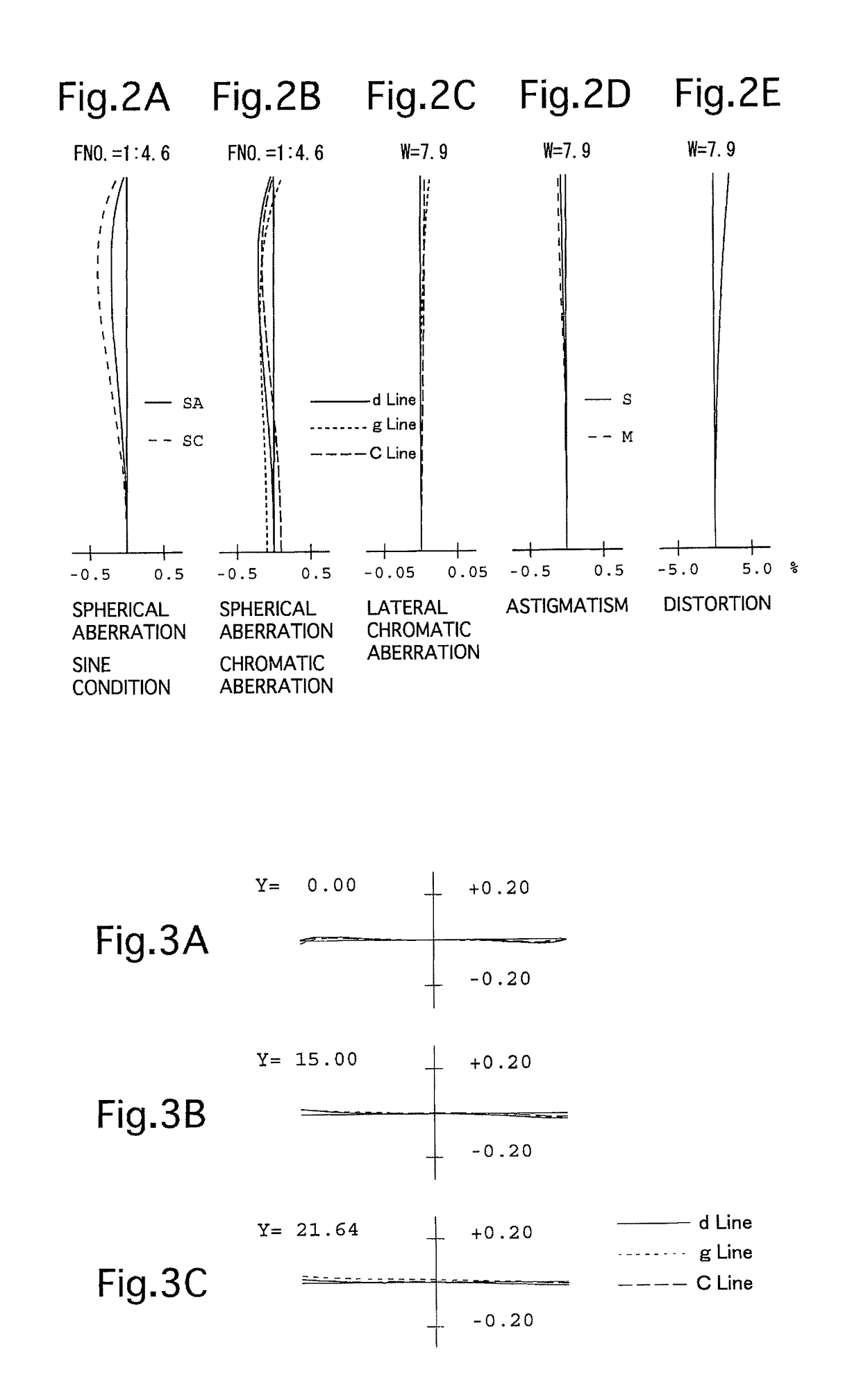Zoom lens system
a zoom lens and lens body technology, applied in the field of zoom lens systems, can solve the problems of deteriorating optical quality, reducing the quantity of peripheral light at the long focal length extremity, increasing weight and complexity, and affecting the quality of optical reproduction, so as to achieve favorable correction of various aberrations and superior optical quality
- Summary
- Abstract
- Description
- Claims
- Application Information
AI Technical Summary
Benefits of technology
Problems solved by technology
Method used
Image
Examples
embodiment 1
[0131][Numerical Embodiment 1]
[0132]FIGS. 1 through 6C and Tables 1 through 3 show a first numerical embodiment of a zoom lens system according to the present invention. FIG. 1 is a lens arrangement of the zoom lens system when focused on an object at infinity at the short focal length extremity; FIGS. 2A, 2B, 2C, 2D and 2E show various aberrations that occurred therein; FIGS. 3A, 3B and 3C show lateral aberrations that occurred therein; FIG. 4 is a lens arrangement of the zoom lens system when focused on an object at infinity at the long focal length extremity; FIGS. 5A, 5B, 5C, 5D and 5E show various aberrations that occurred therein; and FIGS. 6A, 6B and 6C show lateral aberrations that occurred therein. Table 1 shows the lens data, Table 2 shows various data, and Table 3 shows lens-group data.
[0133]The zoom lens system of the first numerical embodiment is configured of a positive first lens group G1, a negative second lens group G2, a negative third lens group G3, a positive fou...
embodiment 2
[0142][Numerical Embodiment 2]
[0143]FIGS. 7 through 12C and Tables 4 through 6 show a second numerical embodiment of a zoom lens system according to the present invention. FIG. 7 is a lens arrangement of the zoom lens system when focused on an object at infinity at the short focal length extremity; FIGS. 8A, 8B, 8C, 8D and 8E show various aberrations that occurred therein; FIGS. 9A, 9B and 9C show lateral aberrations that occurred therein; FIG. 10 is a lens arrangement of the zoom lens system when focused on an object at infinity at the long focal length extremity; FIGS. 11A, 11B, 11C, 11D and 11E show various aberrations that occurred therein; and FIGS. 12A, 12B and 12C show lateral aberrations that occurred therein. Table 4 shows the lens data, Table 5 shows various data, and Table 6 shows lens-group data.
[0144]The lens arrangement of the second numerical embodiment differs from the lens arrangement of the first numerical embodiment with respect to the following features:
[0145](1)...
embodiment 3
[0151][Numerical Embodiment 3]
[0152]FIGS. 13 through 18C and Tables 7 through 9 show a third numerical embodiment of a zoom lens system according to the present invention. FIG. 13 is a lens arrangement of the zoom lens system when focused on an object at infinity at the short focal length extremity; FIGS. 14A, 14B, 14C, 14D and 14E show various aberrations that occurred therein; FIGS. 15A, 15B and 15C show lateral aberrations that occurred therein; FIG. 16 is a lens arrangement of the zoom lens system when focused on an object at infinity at the long focal length extremity; FIGS. 17A, 17B, 17C, 17D and 17E show various aberrations that occurred therein; and FIGS. 18A, 18B and 18C show lateral aberrations that occurred therein. Table 7 shows the lens data, Table 8 shows various data, and Table 9 shows lens-group data.
[0153]The lens arrangement of the third numerical embodiment differs from the lens arrangement of the first numerical embodiment with respect to the following features:
[...
PUM
 Login to View More
Login to View More Abstract
Description
Claims
Application Information
 Login to View More
Login to View More - R&D
- Intellectual Property
- Life Sciences
- Materials
- Tech Scout
- Unparalleled Data Quality
- Higher Quality Content
- 60% Fewer Hallucinations
Browse by: Latest US Patents, China's latest patents, Technical Efficacy Thesaurus, Application Domain, Technology Topic, Popular Technical Reports.
© 2025 PatSnap. All rights reserved.Legal|Privacy policy|Modern Slavery Act Transparency Statement|Sitemap|About US| Contact US: help@patsnap.com



